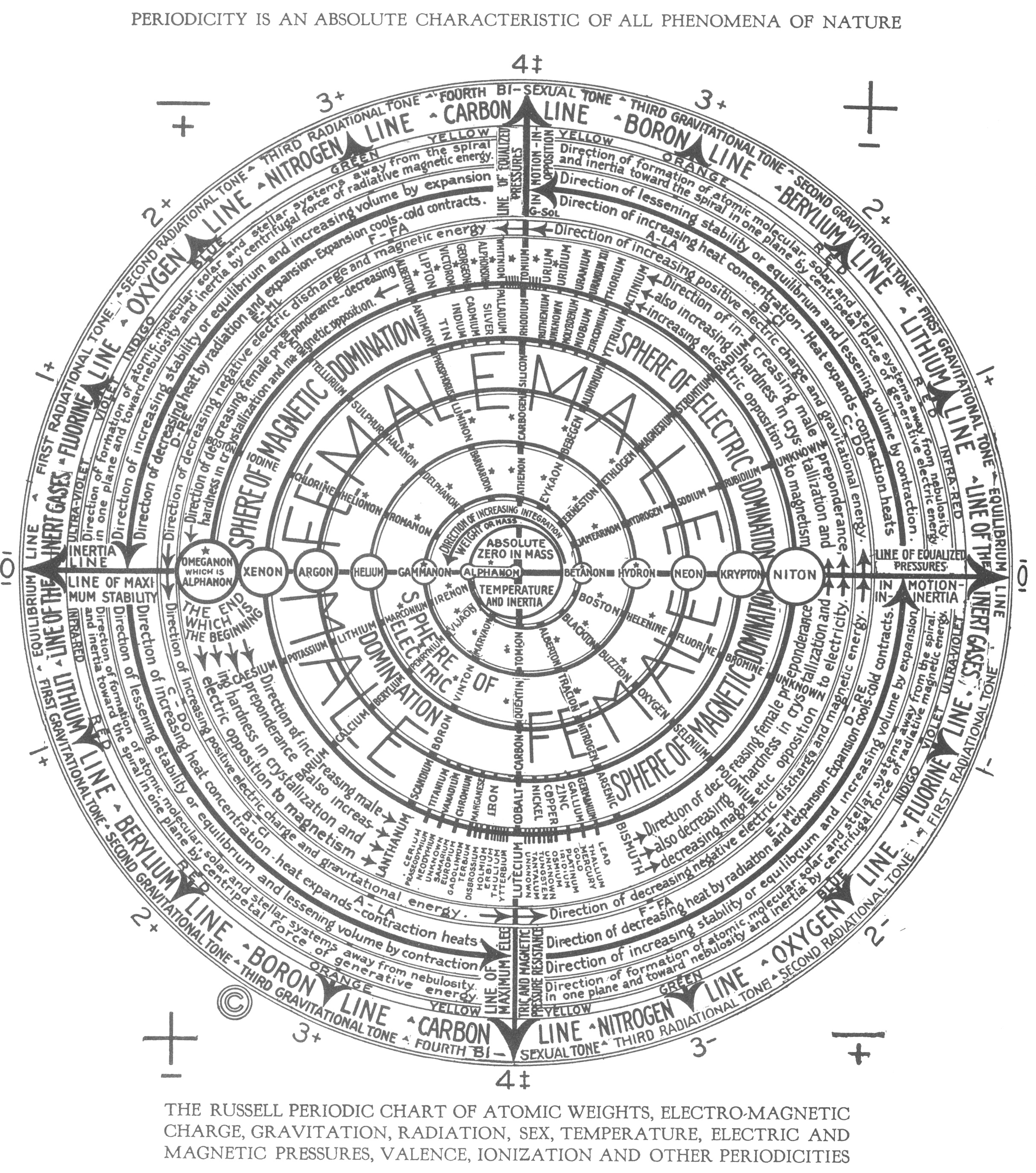
Atomic weight (symbol: Ar) is a dimensionless physical quantity, the ratio of the average mass of atoms of an element (from a given source) to 1/12 of the mass of an atom of carbon-12 (known as the unified atomic mass unit). The term is usually used, without further qualification, to refer to the standard atomic weights published at regular intervals by the International Union of Pure and Applied Chemistry (IUPAC) and which are intended to be applicable to normal laboratory materials. These standard atomic weights are reprinted in a wide variety of textbooks, commercial catalogues, wallcharts etc. The fact "relative atomic mass of the element" may also be used to describe this physical quantity, and indeed the continued use of the term "atomic weight" has attracted considerable controversy since at least the 1960s.
Atomic weights, unlike atomic masses (the masses of individual atoms), are not physical constants and vary from sample to sample. Nevertheless, they are sufficiently constant in "normal" samples to be of fundamental importance in chemistry. [Wikipedia]
The IUPAC definition of atomic weight is:
An atomic weight (relative atomic mass) of an element from a specified source is the ratio of the average mass per atom of the element to 1/12 of the mass of an atom of 12C.
The definition deliberately specifies "An atomic weight", as an element will have different atomic weights depending on the source. For example, boron from Turkey has a lower atomic weight than boron from California, because of its different isotopic composition. Nevertheless, given the cost and difficulty of isotope analysis, it is usual to use the tabulated values of standard atomic weights which are ubiquitous in chemical laboratories. [Wikipedia]
Keely
Dr. Macvicar, in his theories of the bearing of the cosmical law of assimilation on molecular action, says: "During this retreat of matter into ether in single material elements or units of weight, the molecules and masses from which such vaporization into the common vapor of matter is going on, may be expected to be phosphorescent." This surmise Keely has, over and over, demonstrated as a fact, also showing how gravitation operates as a lever, etheric wave motion, concentration under vibratory concussion, and negative vacuous tenuity. [Snell Manuscript - The Book, page 2]
"All atoms when in a state of tension are capable of oscillating at a pitch inversely as the cube of their atomic weights, and directly as their tension from 42 to 63 octaves per second, producing the creative force (Thermism), whose transmissive force (Rad-energy) propagated in solid, liquid, and gaseous ether, produces the static effects (Cohesion and Chemism) on other atoms of association, or dissociation, according to the Law of Harmonic Attraction and Law of Repulsion.
Scholium: Dark radiant heat begins at absolute zero temperature, and extends through light, chemical rays, actienic rays, and infra-violet rays, up to the dissociation of all molecules to the 63rd octave." [Keely, pre1894] [Dashed Against the Rock]
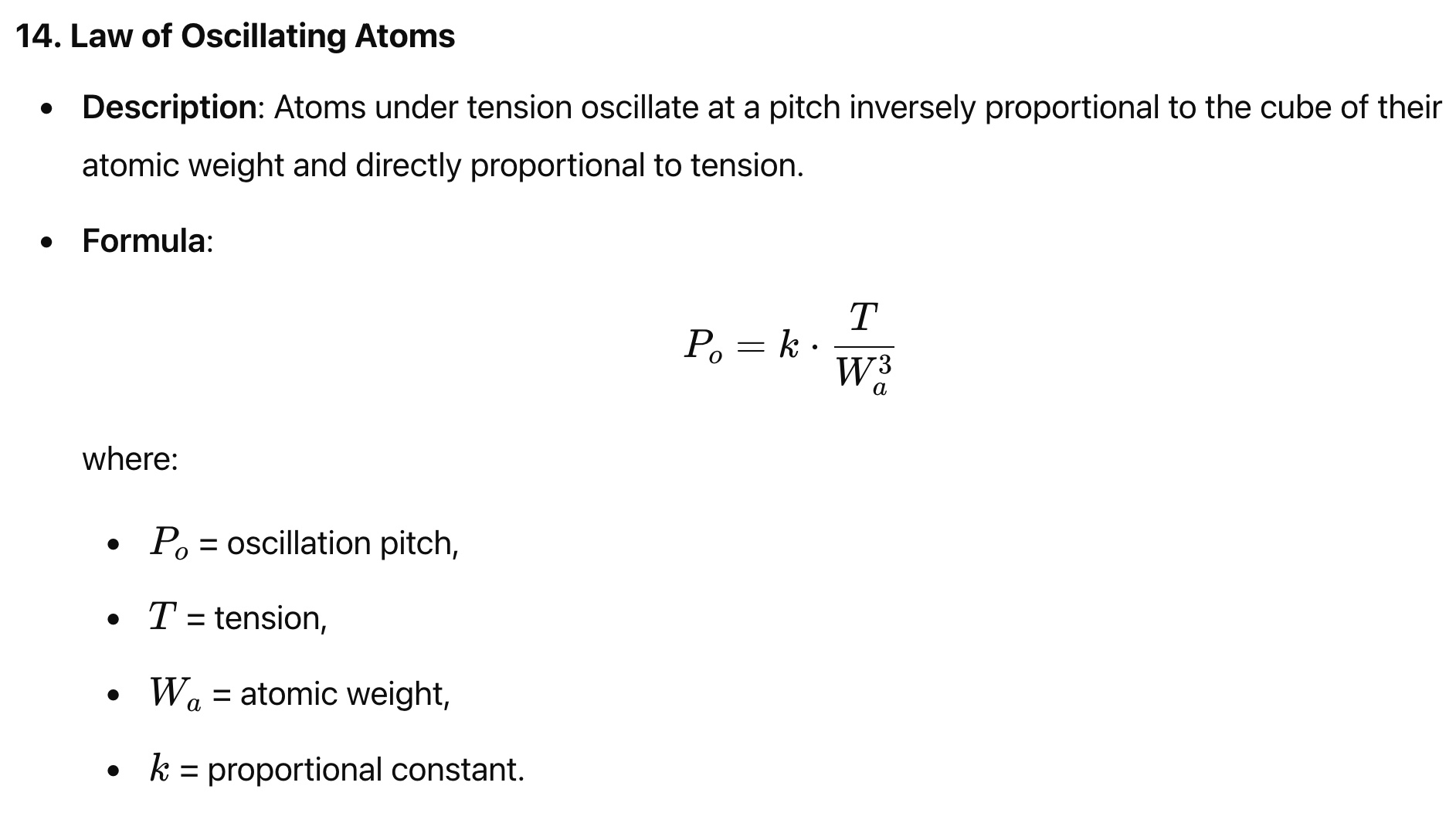
Commentary - April, 2017
It has been deduced Keely was at times and for specific purposes using atomic substances as Creative resonators whose vibratory (heat) emissions could be used to influence or modulate other substances. In the vibration range given "42 to 63 octaves" the atomic substance would be thermally excited (heated). The above law provides a method to calculate precise frequencies. The resultant thermal emissions (heat) when specifically controlled would produce association, dissociation and other physical and chemical effects such as melting, alloying and the like. All this seems trivial and not anything new until the Laws of Harmony and Repulsion are considered. A review of the Bjerknes Effect and Sympathetic Association might be in order.
Return to Keelys Forty Laws
See Also
Actinic
Blue
Chemism
co-oscillation
Father-Mother Principle
Fraunhofer Lines
Keelys Forty Laws
Law of Attraction
Law of Attraction and Repulsion
Law of Harmonic Pitch
Law of Harmonic Vibrations
Law of Harmony
Law of Oscillating Atoms
Law of Repulsion
Law of Transformation of Forces
Rad-Energy
Scale of the Forces in Octaves
Table 14.03 - Ranges of Forces Vibration Forms Types and Governing Laws
8.12 - Law of Attraction
8.13 - Law of Repulsion
8.17 - Law of Harmonic Vibrations
8.22 - Law of Harmonic Pitch
9.4 - Law of Attraction
9.5 - Law of Repulsion
17.12 - Law of Oscillating Atomoles
Law of Vibrating Atomolic Substances
"Atoms are capable of vibrating within themselves at a pitch inversely as the Dyne (the local coefficient of Gravity), and as the atomic volume, directly as the atomic weight, producing the creative force (Electricity), whose transmissive force is propagated through atomolic solids, liquids, and gases, producing induction and the static effect of magnetism upon other atoms of attraction or repulsion, according to the Law of Harmonic Attraction and Repulsion.
Scholium: The phenomenon of Dynamic Electricity through a metallic conductor and of induction are identical. In a metallic conductor, the transmission is from atom to atom, through homologous interstices, filled with ether, presenting small areas in close proximity. In crystalline structures, heat, which expands the atoms, by twisting them produces striae, increases the resistance, etc. Between parallel wires and through air the induction takes place from large areas through a rarefied medium composed of a mixture of substances, whose atoms are separated by waves of repulsion of various pitches, discordant to electric vibrations; the said atoms sympathetically absorb the vibrations and dissipate from themselves, as centers, concentric waves of electric energy which produces heat and gravism." [Keely, 1894]
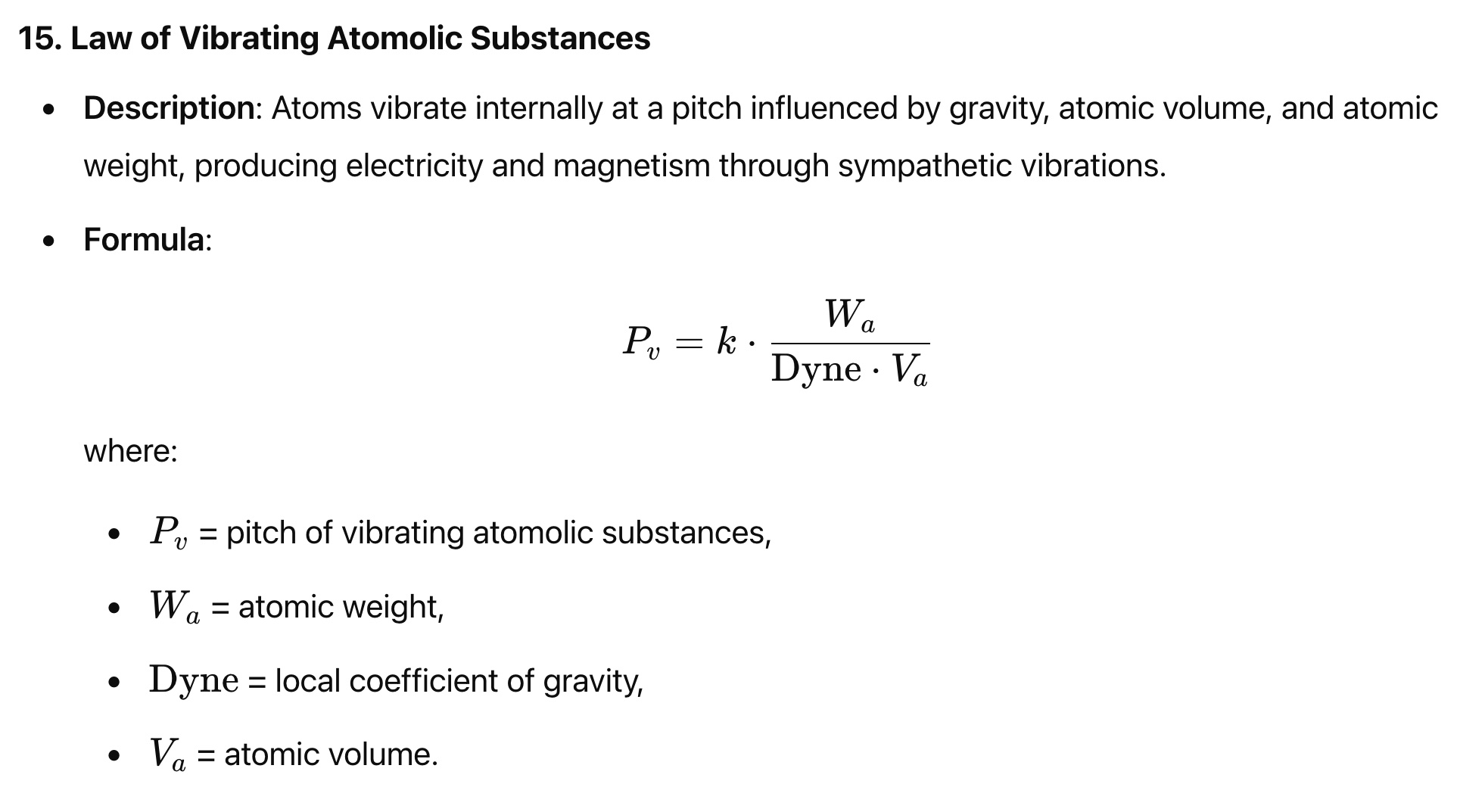
Commentary May, 2017
An entire book could be written explaining this law and its utility to us. Of course we’re not going to go into that kind of depth here. This law describes the dynamic of electricity; its creative state, transmissive state and effects on other bodies. But then this law is not about electricity per se but about the dynamism of the vibrating atomolic/etheric medium which conducts or conveys the electric stream, flow or current. As Keely says: "Electricity is the oscillation of the atomoles of an atom." [Keely]. So electricity is an effect of the oscillations and vibrations of interatomic or quantum entities - just like we moderns have come to consider electricity as a motion of electrons and protons. This Keely asserts years before the electron and proton were acknowledged to exist.
It is curious Keely says magnetism is a static effect while electricity is the active agent of the pair. He says the vibrations of atoms as a composite of the various contributing and modulating forces of Dyne, volume and weight produces the creative state, source or force electricity which then has a transmissive state or force propagating through various phases of matter and energy producing diverse effects including induction and magnetism. [See Law of Force] This sounds to me like a comprehensive definition of electricity something lacking in our modern science and engineering texts. The phenomenon of electricity and magnetism looked at with these detailed insights makes a lot more sense to me than the conventional views which for the most part are too simplistic. The active and functional dynamic of vibrating atoms and its constituents seems to be ignored in modern views. But they do talk about electrons (an atomic constituent) moving to and fro between holes, etc. in a conductor so maybe modern science is not completely ignoring these base and foundational periodic motions.
[1] Atomolic - "The atomolic substance is what is termed the ether which fills all space and is the transmitting medium for all celestial and terrestrial forces. This is the liquid ether of occult science." [Keely]
"For convenience' sake we will use the term atomolic in place of etheric in our subsequent definitions." [Keely, Dashed Against the Rock, p. 47]
[2] Law of Assimilation
Return to Keelys Forty Laws
See Also
Attraction
Bjerknes Effect
cold light
Conduction
Creative
electric current
electric energy
electric stream
electric vibration
Etheric Elements
Gravism
Gravity
Induction
insulating fluid
intermediate substance
Keelys Forty Laws
Law of Assimilation
Law of Assimilation - Examples
Law of Cycles
Law of Force
magnetic conduction
One Substance
Principle of Regeneration
Repulsion
Transmissive
2.3 - Law of Vibrating Atomolic Substances
17.11 - Law of Vibrating Atomolic Substances
8.13 - Law of Repulsion
8.17 - Law of Harmonic Vibrations
8.29 - Law of Vibrating Atomolic Substances
Law of Oscillating Atomoles
"Atomoles oscillating at a uniform pitch (determined by their uniform size and weight) produce the creative force Atomolity, whose transmissive form, Gravism, is propagated through more rarefied media, producing the static effect upon all other atomoles, denominated Gravity." Keely, 1893
See Also
2.4 - Law of Oscillating Atomoles
8.12 - Law of Attraction
8.13 - Law of Repulsion
8.17 - Law of Harmonic Vibrations
8.22 - Law of Harmonic Pitch
9.4 - Law of Attraction
9.5 - Law of Repulsion
14.11 - Ranges of Forces Effects and Actions
17.12 - Law of Oscillating Atomoles
co-oscillation
Creative Force
Ether
Etheric Elements
Father-Mother Principle
Fraunhofer Lines
Gravity
Law of Attraction
Law of Attraction and Repulsion
Law of Harmonic Pitch
Law of Harmonic Vibrations
Law of Harmony
Law of Oscillating Atomic Substances
Law of Oscillating Atoms
Law of Repulsion
Law of Transformation of Forces
oscillate
oscillate
oscillating proximately
oscillating range of motion
Oscillation
oscillatory motion
Pendulum Oscillation
Proximate Oscillation
Ramsay - PLATE IV - Oscillation and Vibration
Ramsay - PLATE V - Proximate and Differential Oscillations
Ramsay - The New Way of Reckoning a Pendulum Oscillation
Part 17 - Gravity
Rad-Energy
Scale of the Forces in Octaves
Table 14.03 - Ranges of Forces Vibration Forms Types and Governing Laws
Law of Atomic Pitch
"Atoms have each a different and definite pitch, at which they naturally vibrate.
Scholium: atomic pitch is determined directly from its simple spectrum.
Scholium: atomic pitch is determined by computations from its associate spectrum with all other atoms, as in known spectra.
Scholium: atomic pitches are more important working data than Atomic weights; tables of atomic pitches must be precise." [Keely, Dashed Against the Rock]
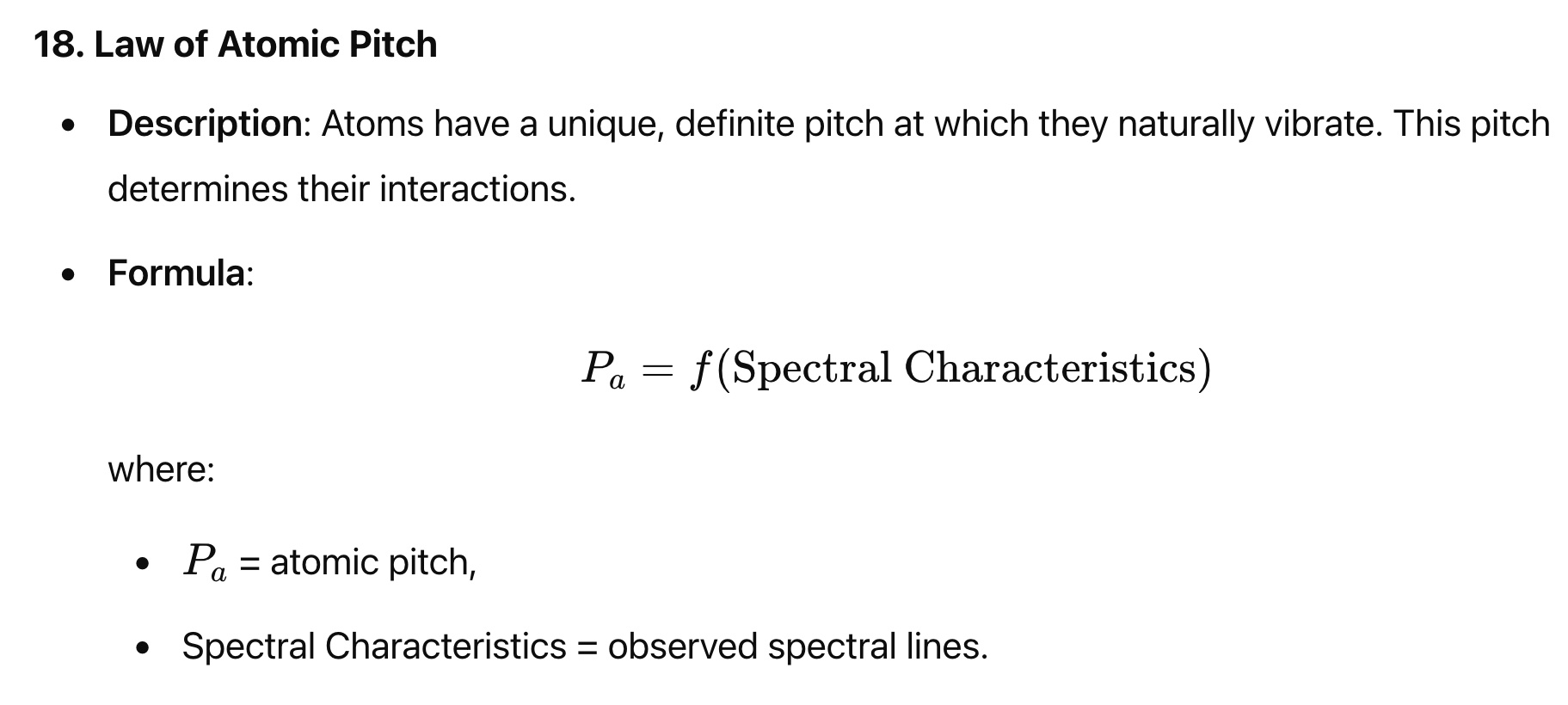
Commentary August, 2017
According to Keely’s own definition of pitch: "Pitch is the relative frequency of vibration." Keely
It is unfortunate modern science uses wave length as a measure of atomic activity and not frequency. Yet they use frequency in some of their calculations. Which means almost all of the data concerning this attribute that is findable is stated in wave length. Of course wave length is a reciprocal of frequency and the conversion is not that difficult. Another issue with conventional science is they tend to use scientific notation (as in rounding off) of large numbers. Such is said to be easier to perform math. Rounding off is not the definition of accuracy. One wonders about all that.
The spectra or spectrum of an element is composed of a collection of frequencies. While there is a fundamental in that collection it (a single frequency) is not all there is to consider. We have then a chord of frequencies. These, each taken as a specific frequency, are to be compared to those of other elements as one would musical notes (relative pitches) to derive the pitch. These comparisons then appear as chords having various degrees of harmony and discord. As we saw in the Law of Attraction, Law of Repulsion and the Bjerknes Effect polarity and its effects boil down to the relative degree of harmony/attraction and discord/repulsion.
These frequencies of the atoms are more important than their weights for working with atoms in chemistry, etc. It is unfortunate that the specific spectra (frequency) of atoms has been held more or less proprietary by those having such data. However there are web sites that publish such data. There are listed several sources on the Spectra page.
A curious work I did some years ago relating the atomic elements to music.
Click here to visit interactive web page: Periodic Table Set to Music
Keely’s Chord of Mass is of course all the frequencies within a body considered as a chord which is the same as our term ’signature’.
Return to Keelys Forty Laws
See Also
Keelys Forty Laws
Law of Transformation of Forces
Laws
Law of Pitch of Atomic Oscillation
"Atoms not isolated and in a state of tension between forces that oppose and increase the equilibrium oscillate bodily at a pitch that is a resultant of the Atomic weight, Atomic volume, and tension." [Keely, 1893]
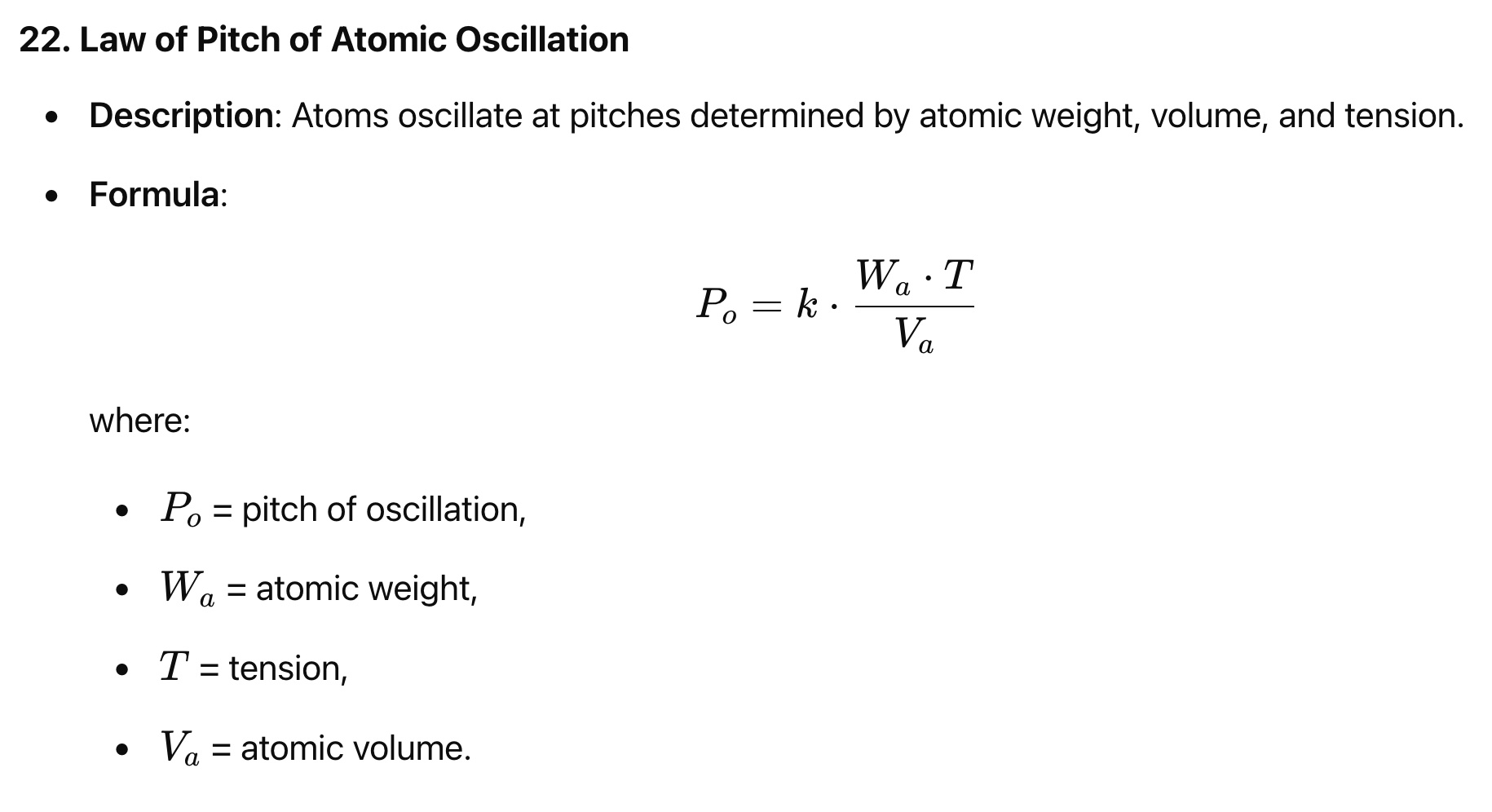
Calculating the pitch or frequency of atoms. As any vibrating object such vibration and oscillation are dependent on weight, volume and tension. For instance calculating the frequency of a guitar or piano string these three variables are taken into account. The difference is the atom exists within the atomic subdivision while the piano string is of the molecular subdivision. Hence the molecular also has another variable, that of substance or mass. A copper string can bear little tension while a tempered steel string can be stretched to a much greater tension.
This law explains in part the dynamic within Russell's Locked Potentials of the elements.
Return to Keelys Forty Laws
See Also
Chart of Locked Potentials
Keelys Forty Laws
Laws
Locked Potentials and Subdivisions
Locked Potentials and the Square Law
Part 12 - Russells Locked Potentials
Scale of Locked Potentials
12.01 - Scale of Locked Potentials
12.04 - Locked Potentials and the Square Law
Law of Variation of Atomic Oscillation by Temperature
"The force of cohesion diminishes inversely as the square of the distance the atoms are apart, and the force of the chemical affinity diminishes in the same ratio. Heat increases the amplitude of the oscillations in a direct ratio to the temperature of the natural scale.
Scholium: New thermometers and accurate thermometric tables, on the natural base, wherein doubling the temperature doubles the pitch of the transmissive energy, are required. Such a table of temperature will bear natural relations to Atomic weights, pitches, specific heats, chemical affinities, fusions, solubilities, etc., and will disclose new laws. One table for each must be constructed." [Keely, pre 1894]
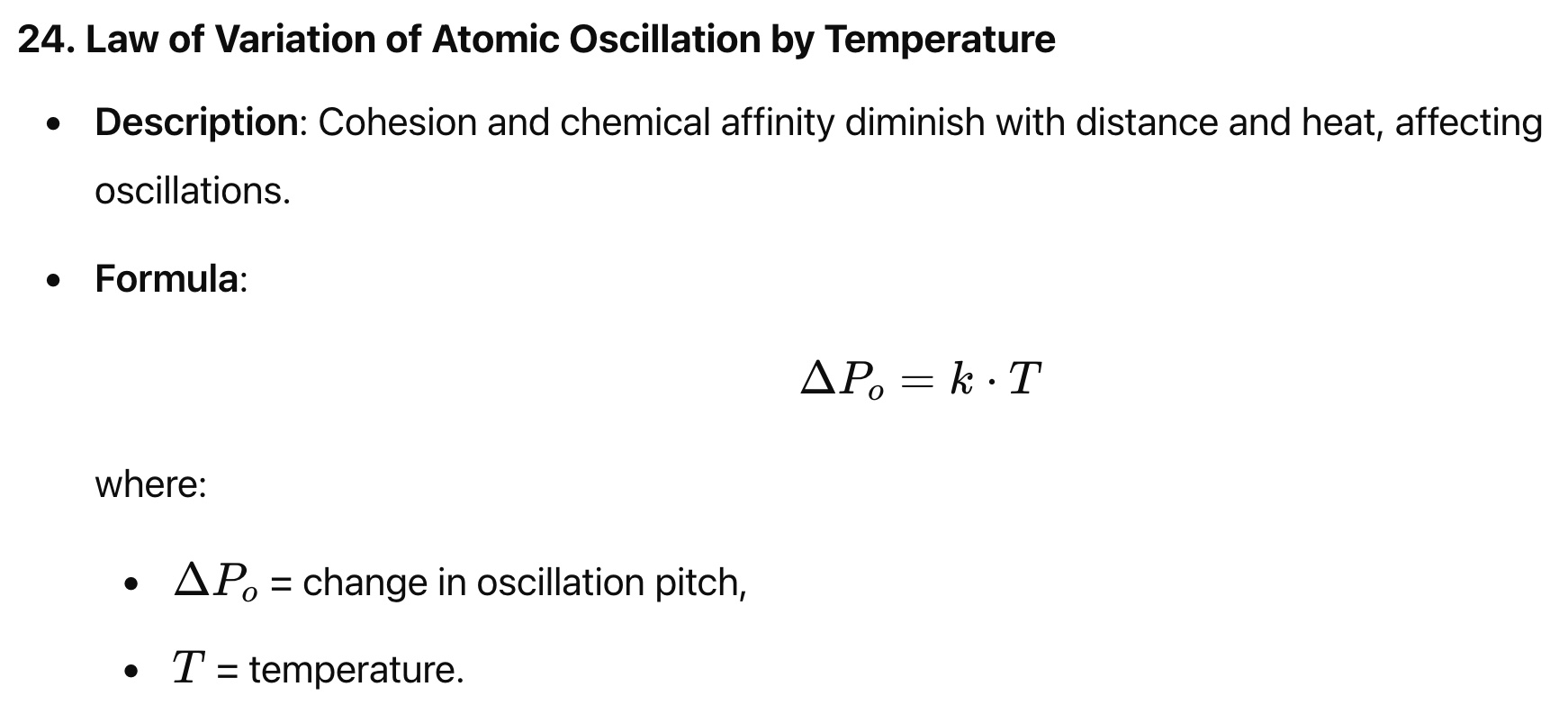
Return to Keelys Forty Laws
See Also
Cohesion
Heat
Keelys Forty Laws
Oscillation
Part 12 - Russells Locked Potentials
spectra
spectral component
variation
Schauberger
[1] See "The Ox and the Chamois" in Nature as Teacher, p.41, Vol. II of the Ecotechnology series. — Ed.
[2] H-substance: here refers to hydrogen or hydrogen-like substances. — Ed.
[3] Phos-elements: It is not quite clear what is intended here, but it may relate in some way to bioluminescence. However, the following three definitions are provided as an aid to interpretation.
PHOSPHOR: A substance which is capable of luminescence, i.e. storing energy (particularly from ionising radiation) and later releasing it in the form of light. If the energy is released after only a short delay (between 10-10 and 10-4 seconds) the substance is called a 'scintillator'.
PHOSPHORUS: P. Element. Atomic weight 30.9738. Atomic number 15. Occurs in several allotropic forms, white phosphorus and red phosphorus being the commonest. The former is a waxy white, very inflammable and poisonous solid. Red phosphorus is a non-poisonous, dark red powder, not very inflammable. The element only occurs in the combined state, mainly as calcium phosphate, CA3(PO4)2, Essential to life; calcium phosphate is the main constituent of animal bones.
PHOSPHATE: Salt of phosphoric acid H3PO4. Phosphates are used as fertilisers to rectify a deficiency of phosphorus in the soil. Note: The editor regrets that he cannot locate the dictionary from which the information was originally sourced.' [The Energy Evolution - Harnessing Free Energy from Nature, Letter to Werner Zimmermann]
John Dalton
"Atomic weight is the rate of vibration." [John Dalton]
See Also
Frequency
Law of Atomic Pitch
Law of Oscillating Atoms
Law of Pitch of Atomic Oscillation
Law of Variation of Atomic Oscillation by Temperature
Law of Vibrating Atomolic Substances
Mass
Weight
